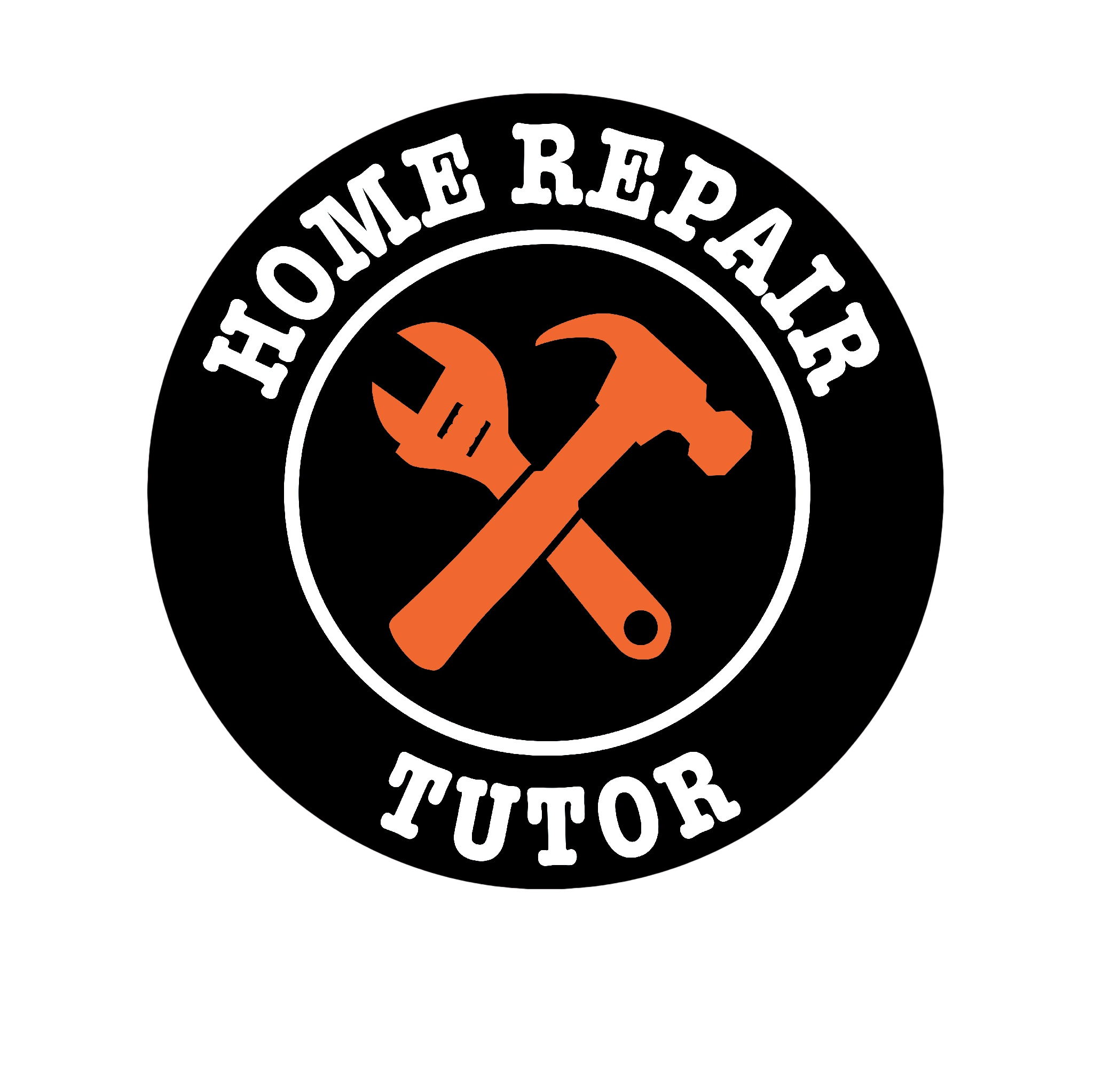How do you remove old carpet?
This question is for all of us who bought a new house that has that crazy red shag carpet circa 1976.
Which pretty much means anyone who’s ever bought a house in Pittsburgh’s city limits (I’m allowed to make fun of my own city’s styling flaws).
Removing carpet isn’t hard and I have a handful of really awesome tips to share with you…
…along with a detailed step-by-step checklist and video of this entire process.
Carpet Removal Supplies
Start by assembling your supplies. Here’s a list to help you out:
- Utility knife
- Duct tape
- Gloves (personally LOVE Iron Clad)
- Dust mask
- Pliers
- Pry bar
- Hammer
- Ring shank nails
- Old beach towel
The total cost for all the supplies is $59.62.
But if you have a utility knife, pliers, and a hammer then the cost drops to $31.69. Hey, that’s cheaper than seeing the latest Disney kids movie in 3D with your family!!
Why would you want to remove your carpet yourself? Well, this is a great time to inspect the subfloor for any damage or squeaks.
Once the new carpet goes down you won’t be able to fix these problems. And I promise you that not every carpet installer is going to care about your home as much as you.
There’s nothing worse than a fantastic carpet that’s squeaky, trust me here!!!!
Carpet removal takes 30-60 minutes while pad removal is another 30-45 minutes depending on the size of your room. This post is chalked full of tips that’ll make removing carpet so much easier for you.
So let’s get to it!
How to Easily Remove Old Carpet
You can remove carpet from your house all by yourself and without breaking your back. How do I know this? Well, I’ve done it and lived to share my stories of dog urine, bloodstains, and other unmentionable things that’ll give anyone nightmares.
Yeah pretty disgusting stuff!! But that’s what you get when you rehab rentals.
Most of the time old carpet is not underneath the baseboards (baseboards are the trim pieces that sit at the bottom of your wall). Thus, you shouldn’t have to remove the baseboards when taking out smelly carpet.
Start at one corner of your room and try to pull up the carpet. If it won’t come up then cut a small 6 inch by 6 inch square in the corner with your utility knife. Remove this small piece of carpet and then pull up on the larger section.
Your carpet is held down with tack strips. These little buggers are along the perimeter of your room, so just be careful not to hurt your hands or knees.
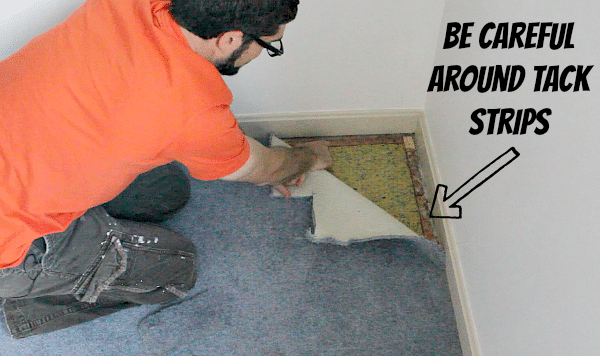
To make the removal process easier, you should fold the carpet into the center of the room. I like to think of the carpet as a piece of paper and fold it into thirds.
Fold one-third of the carpet into the center of the room then cut the fold with your utility knife (Don’t worry, I show you how to do this in my video but please don’t comment on my messy hair. It was a long day of projects).
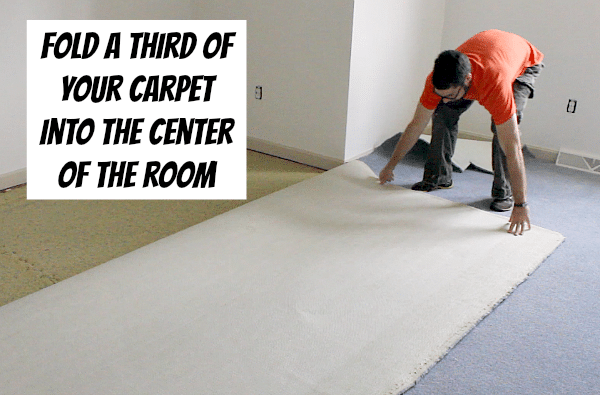
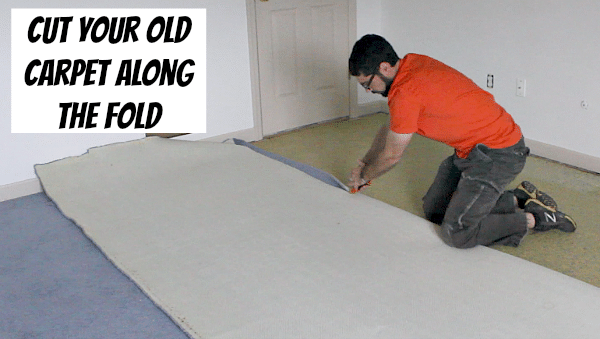
HOT TIP: Place both your hands on the utility knife while cutting carpet so that you don’t cut your FINGER OFF.
This will allow you to roll up the carpet into manageable pieces. Both you and your garbage person will have healthier backs and be in better moods if you use this tactic. You can use duck tape to secure the roll of carpet.

If you have a closet, you can cut the carpet where it meets up with the closet doors. This helps you handle the carpet a bit better when rolling it into thirds. And you’ll have one small piece to manage that’s in the closet.
In the end, you’ll have 3 large rolls of carpet that one person can take to the trash along with one small section from the closet (I prefer to throw this one out the window just for show-kidding here!!).
Here’s a video, it contains all my juicy tips wrapped up into one masterpiece.
Now you can tackle the padding.
How to Remove Carpet Padding
Carpet padding will be in smaller sections already. It’s tacked down with staples most of the time. If you’re unlucky, it’ll be secured to the wood subfloor or your concrete pad with glue.
I’m only gonna show you how to remove stapled-down padding.
Staples are only along the perimeter of the padding sections. Put on a pair of gloves if you have them because sometimes the staples get pulled up along with the padding and you’ll jab yourself. OUCH at best.
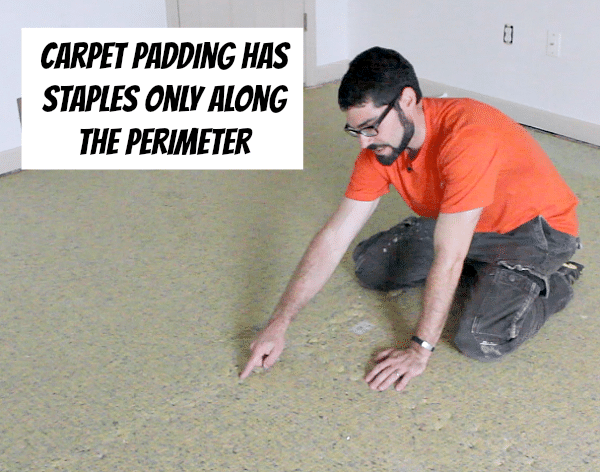
Grab a section of padding at the corner and simply pull it up by hand.
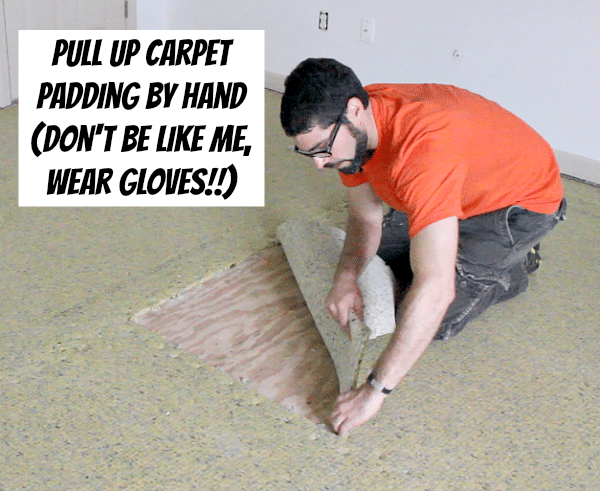
Roll up the pad and duck tape it just like you did with the carpet. In some cases, the padding will be a long roll.
You can fold it over on itself then duck tape it again. Padding is super light compared to carpet. So doing the double roll thing won’t kill your back 🙂
The next step is to check your floor for squeaks and remove loose staples or rusted tack strips. RUSTED TACK STRIPS!!! I’ll explain why you should look for them.
Subfloor Inspections, Removing Staples & Tack Strips
Walk around the perimeter of your room and look at the tack strips. If you see that they’re rusted this indicates
- A pet did its business on your floor at one time or another
- Someone spilled a drink or some other unidentifiable liquid
- There may have been a roof leak (which you’ll want to verify)
Either way, you need to inspect the wood subfloor (if you don’t have a cement pad). Make sure it’s solid and doesn’t flex too much. You’ll likely see a liquid stain on wood subfloor panels if the tack strips are rusted.
Any rusted tack strips should be removed and the carpet guys or gals will put new ones in.
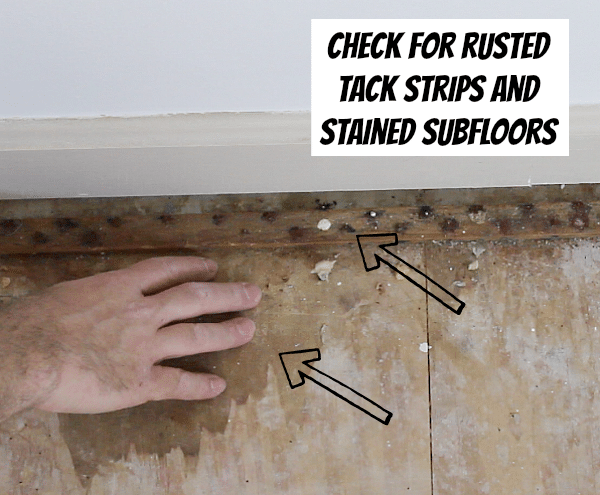
You can leave the tack strips on your subfloor if you’re going to install a new carpet. But, if you want to have new hardwood, laminate, or tile floors the tack strips need to be taken out.
Find the nails that hold the tack strip to the floor. Slide a pry bar under these nails then lift up on the strip. You may also need to pound the pry bar under the tack strip with a hammer.
The next step is to literally walk on every single wood subfloor panel. I strongly encourage you to bounce up and down while doing this.
Sure, it’ll look like you’re having your own personal dance party but that’s what you need to do. You’re checking for squeaks and creaks.
Like I said earlier, there’s nothing worse than spending $500-$2000 on beautiful carpet only to find that your room is squeaky.
Subfloor panels are attached to wood joists with screws or nails. When (not if) you find a subfloor panel that crows like, well like a crow, you need to secure it to the joist with ring shank nails.
Why ring shank nails? They’re grooved and have superior gripping power versus other nails. This means it’s highly unlikely the wood panel will become loose again.
Just pound a few ring-shank nails into the panel where you spotted the noise. I like to space the new nails about two inches away from the old ones.
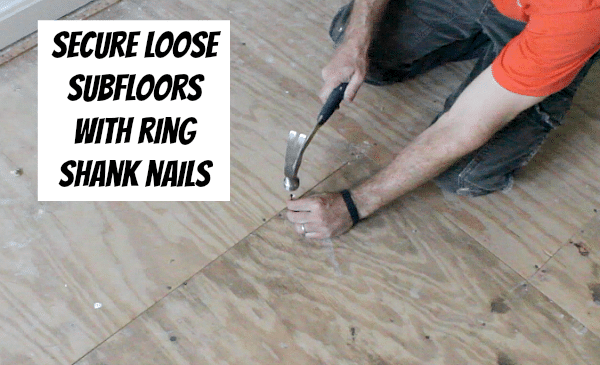
Once you quiet all the panels you now have the unenviable task of removing all the staples. Again, this is especially important if you’re laying down wood, laminate, or tile flooring because the staples will make the new solid floors uneven.

If you’re laying down a new carpet try to take out as many staples as possible using either a pry bar or pliers. This is a simple task but a true pain in the A$$.
So be prepared to spend a good 30-45 minutes. And it also makes sense to use a folded-up towel underneath your poor knees.
What’s Next
Fix squeaky floors before installing carpet or hardwood floors.
If you’re doing a bathroom remodel and need help, join one of our online courses – they’ll make your bathroom renovation much easier!
Let me know if you have any questions and I’ll do my best to help.
Thanks as always for reading, watching, and being part of our awesome community.
Cheers,
Jeff


